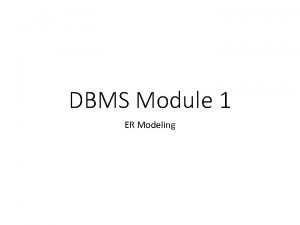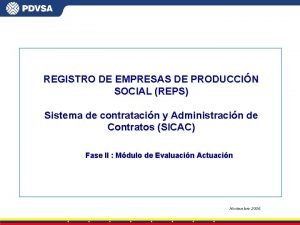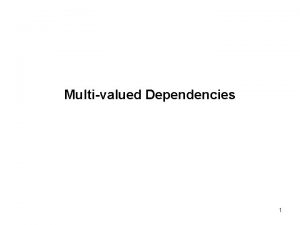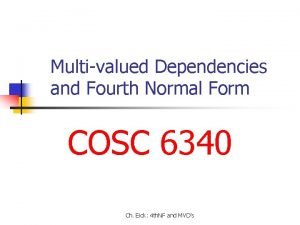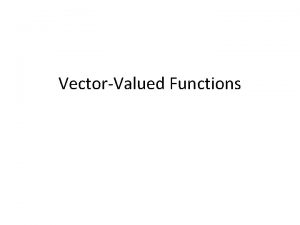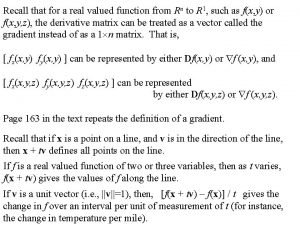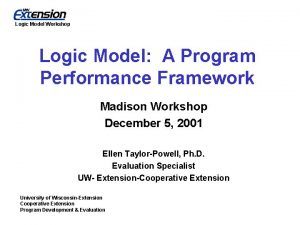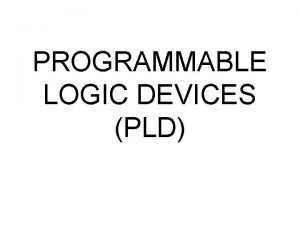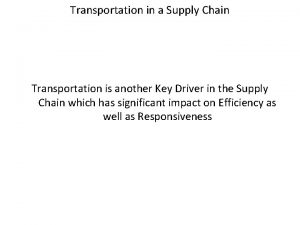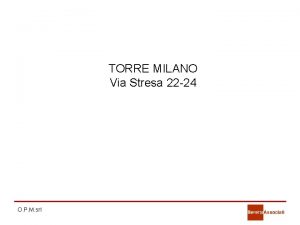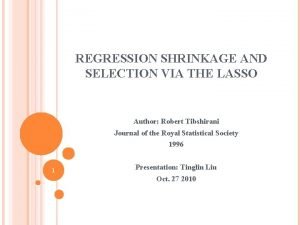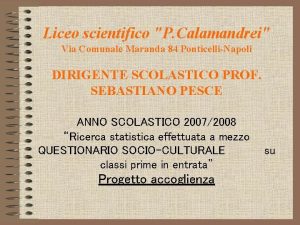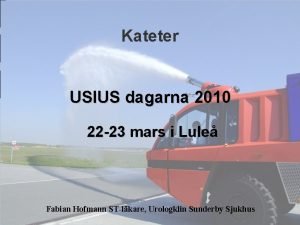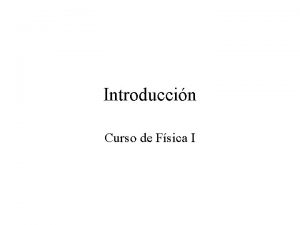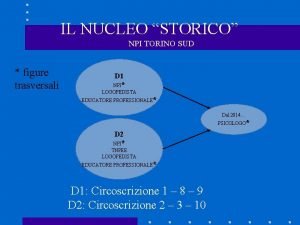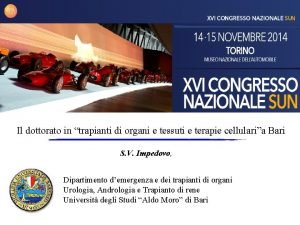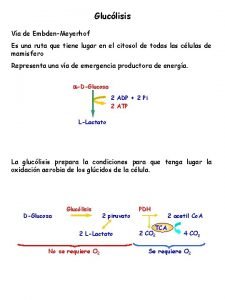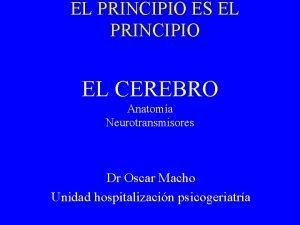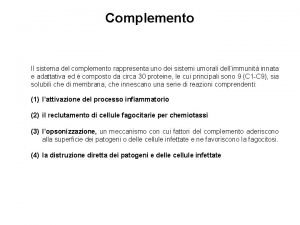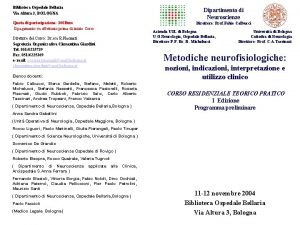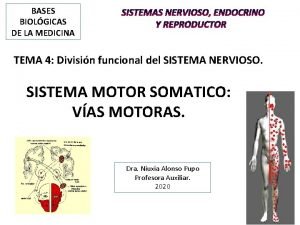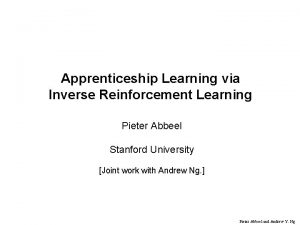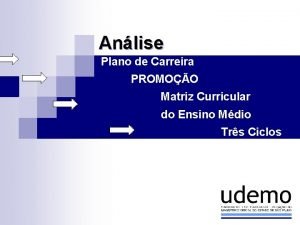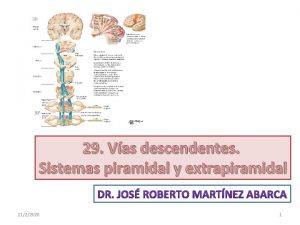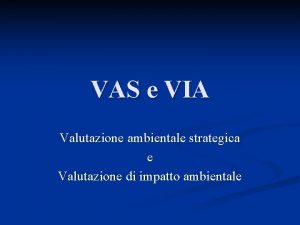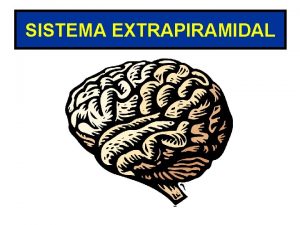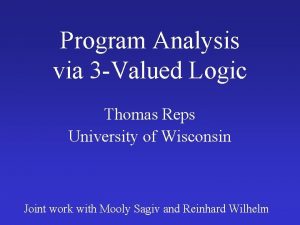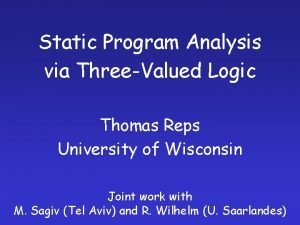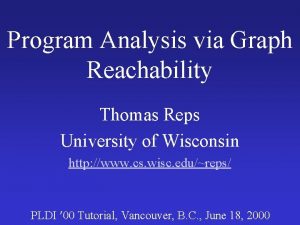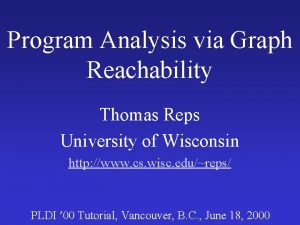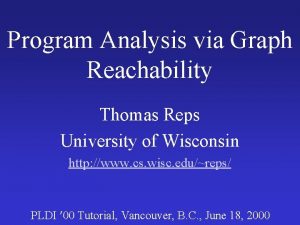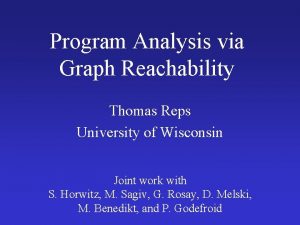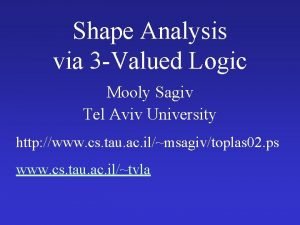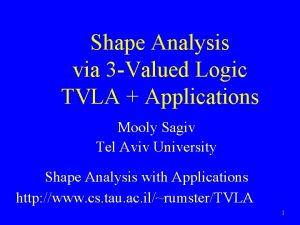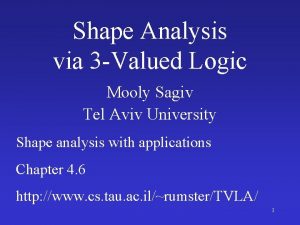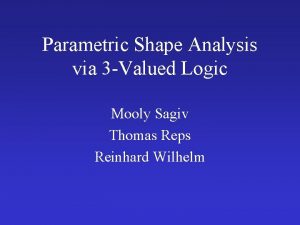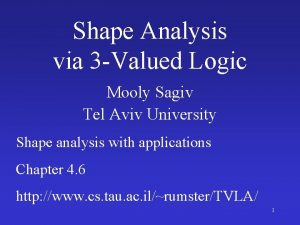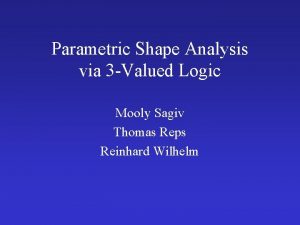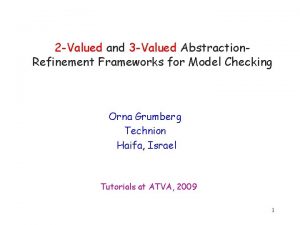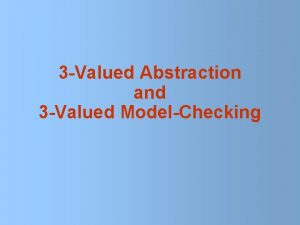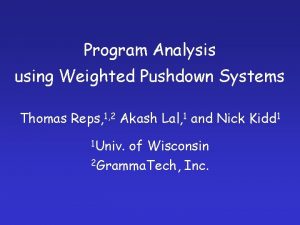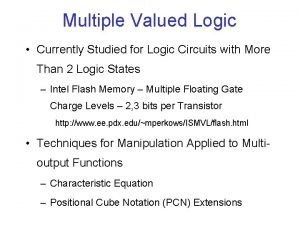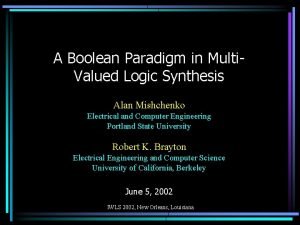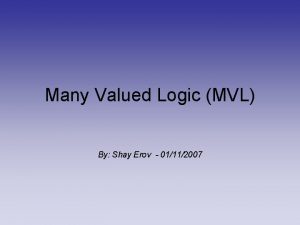Program Analysis via 3 Valued Logic Thomas Reps







































































![Boolean Connectives [Kleene] Boolean Connectives [Kleene]](https://slidetodoc.com/presentation_image/ead077a34dcaea6a34941f7447cdc6e4/image-72.jpg)





















































- Slides: 125

Program Analysis via 3 -Valued Logic Thomas Reps University of Wisconsin Joint work with Mooly Sagiv and Reinhard Wilhelm

Example: In-Situ List Reversal typedef struct list_cell { int val; struct list_cell *next; } *List; List reverse (List x) { List y, t; y = NULL; while (x != NULL) { t = y; y = x; x = x next; y next = t; } return y; } t NULL y 1 2 x 3 NULL

Example: In-Situ List Reversal typedef struct list_cell { int val; struct list_cell *next; } *List; List reverse (List x) { List y, t; y = NULL; while (x != NULL) { t = y; y = x; x = x next; y next = t; } return y; } t NULL y 1 2 x 3 NULL

Example: In-Situ List Reversal typedef struct list_cell { int val; struct list_cell *next; } *List; List reverse (List x) { List y, t; y = NULL; while (x != NULL) { t = y; y = x; x = x next; y next = t; } return y; } t NULL y 1 2 x 3 NULL

Example: In-Situ List Reversal typedef struct list_cell { int val; struct list_cell *next; } *List; List reverse (List x) { List y, t; y = NULL; while (x != NULL) { t = y; y = x; x = x next; y next = t; } return y; } t NULL y 1 2 x 3 NULL

Example: In-Situ List Reversal typedef struct list_cell { int val; struct list_cell *next; } *List; List reverse (List x) { List y, t; y = NULL; while (x != NULL) { t = y; y = x; x = x next; y next = t; } return y; } t NULL y 1 2 x 3 NULL

Example: In-Situ List Reversal typedef struct list_cell { int val; struct list_cell *next; } *List; List reverse (List x) { List y, t; y = NULL; while (x != NULL) { t = y; y = x; x = x next; y next = t; } return y; } t NULL y 1 2 x 3 NULL

Example: In-Situ List Reversal typedef struct list_cell { int val; struct list_cell *next; } *List; List reverse (List x) { List y, t; y = NULL; while (x != NULL) { t = y; y = x; x = x next; y next = t; } return y; } t NULL y 1 2 x 3 NULL

Example: In-Situ List Reversal typedef struct list_cell { int val; struct list_cell *next; } *List; List reverse (List x) { List y, t; y = NULL; while (x != NULL) { t = y; y = x; x = x next; y next = t; } return y; } t NULL y 1 2 x 3 NULL

Example: In-Situ List Reversal typedef struct list_cell { int val; struct list_cell *next; } *List; List reverse (List x) { List y, t; y = NULL; while (x != NULL) { t = y; y = x; x = x next; y next = t; } return y; } t NULL y 1 2 x 3 NULL

Example: In-Situ List Reversal typedef struct list_cell { int val; struct list_cell *next; } *List; List reverse (List x) { List y, t; y = NULL; while (x != NULL) { t = y; y = x; x = x next; y next = t; } return y; } t NULL y 1 2 x 3 NULL

Example: In-Situ List Reversal typedef struct list_cell { int val; struct list_cell *next; } *List; List reverse (List x) { List y, t; y = NULL; while (x != NULL) { t = y; y = x; x = x next; y next = t; } return y; } t NULL y 1 2 x 3 NULL

Example: In-Situ List Reversal typedef struct list_cell { int val; struct list_cell *next; } *List; List reverse (List x) { List y, t; y = NULL; while (x != NULL) { t = y; y = x; x = x next; y next = t; } return y; } t NULL y 1 2 x 3 NULL

Example: In-Situ List Reversal typedef struct list_cell { int val; struct list_cell *next; } *List; List reverse (List x) { List y, t; y = NULL; while (x != NULL) { t = y; y = x; x = x next; y next = t; } return y; } t NULL y 1 2 x 3 NULL

Example: In-Situ List Reversal typedef struct list_cell { int val; struct list_cell *next; } *List; List reverse (List x) { List y, t; y = NULL; while (x != NULL) { t = y; y = x; x = x next; y next = t; } return y; } t NULL y 1 2 x 3 NULL

Example: In-Situ List Reversal typedef struct list_cell { int val; struct list_cell *next; } *List; List reverse (List x) { List y, t; y = NULL; while (x != NULL) { t = y; y = x; x = x next; y next = t; } return y; } t NULL y 1 2 x 3 NULL

Example: In-Situ List Reversal typedef struct list_cell { int val; struct list_cell *next; } *List; List reverse (List x) { List y, t; y = NULL; while (x != NULL) { t = y; y = x; x = x next; y next = t; } return y; } t y x

Example: In-Situ List Reversal typedef struct list_cell { int val; struct list_cell *next; } *List; List reverse (List x) { List y, t; y = NULL; while (x != NULL) { t = y; y = x; x = x next; y next = t; } return y; } t y NULL x

Example: In-Situ List Reversal typedef struct list_cell { int val; struct list_cell *next; } *List; List reverse (List x) { List y, t; y = NULL; while (x != NULL) { t = y; y = x; x = x next; y next = t; } return y; } t y NULL x

Example: In-Situ List Reversal typedef struct list_cell { int val; struct list_cell *next; } *List; List reverse (List x) { List y, t; y = NULL; while (x != NULL) { t = y; y = x; x = x next; y next = t; } return y; } t y NULL x

Example: In-Situ List Reversal typedef struct list_cell { int val; struct list_cell *next; } *List; List reverse (List x) { List y, t; y = NULL; while (x != NULL) { t = y; y = x; x = x next; y next = t; } return y; } t y NULL x Materialization

Example: In-Situ List Reversal typedef struct list_cell { int val; struct list_cell *next; } *List; List reverse (List x) { List y, t; y = NULL; while (x != NULL) { t = y; y = x; x = x next; y next = t; } return y; } t y NULL x

Example: In-Situ List Reversal typedef struct list_cell { int val; struct list_cell *next; } *List; List reverse (List x) { List y, t; y = NULL; while (x != NULL) { t = y; y = x; x = x next; y next = t; } return y; } t y NULL x

Example: In-Situ List Reversal typedef struct list_cell { int val; struct list_cell *next; } *List; List reverse (List x) { List y, t; y = NULL; while (x != NULL) { t = y; y = x; x = x next; y next = t; } return y; } t y NULL x

Example: In-Situ List Reversal typedef struct list_cell { int val; struct list_cell *next; } *List; List reverse (List x) { List y, t; y = NULL; while (x != NULL) { t = y; y = x; x = x next; y next = t; } return y; } t y NULL x

Example: In-Situ List Reversal typedef struct list_cell { int val; struct list_cell *next; } *List; List reverse (List x) { List y, t; y = NULL; while (x != NULL) { t = y; y = x; x = x next; y next = t; } return y; } t y NULL x

Example: In-Situ List Reversal typedef struct list_cell { int val; struct list_cell *next; } *List; List reverse (List x) { List y, t; y = NULL; while (x != NULL) { t = y; y = x; x = x next; y next = t; } return y; } t y NULL x

Example: In-Situ List Reversal typedef struct list_cell { int val; struct list_cell *next; } *List; List reverse (List x) { List y, t; y = NULL; while (x != NULL) { t = y; y = x; x = x next; y next = t; } return y; } t y x

Example: In-Situ List Reversal typedef struct list_cell { int val; struct list_cell *next; } *List; List reverse (List x) { List y, t; y = NULL; while (x != NULL) { t = y; y = x; x = x next; y next = t; } return y; } t y x

Example: In-Situ List Reversal typedef struct list_cell { int val; struct list_cell *next; } *List; List reverse (List x) { List y, t; y = NULL; while (x != NULL) { t = y; y = x; x = x next; y next = t; } return y; } t y x

Example: In-Situ List Reversal typedef struct list_cell { int val; struct list_cell *next; } *List; List reverse (List x) { List y, t; y = NULL; while (x != NULL) { t = y; y = x; x = x next; y next = t; } return y; } t y x

Example: In-Situ List Reversal typedef struct list_cell { int val; struct list_cell *next; } *List; List reverse (List x) { List y, t; y = NULL; while (x != NULL) { t = y; y = x; x = x next; y next = t; } return y; } t y x

Example: In-Situ List Reversal typedef struct list_cell { int val; struct list_cell *next; } *List; List reverse (List x) { List y, t; y = NULL; while (x != NULL) { t = y; y = x; x = x next; y next = t; } return y; } t y x

Example: In-Situ List Reversal typedef struct list_cell { int val; struct list_cell *next; } *List; List reverse (List x) { List y, t; y = NULL; while (x != NULL) { t = y; y = x; x = x next; y next = t; } return y; } t y x

Example: In-Situ List Reversal typedef struct list_cell { int val; struct list_cell *next; } *List; List reverse (List x) { List y, t; y = NULL; while (x != NULL) { t = y; y = x; x = x next; y next = t; } return y; } t y x

Example: In-Situ List Reversal typedef struct list_cell { int val; struct list_cell *next; } *List; List reverse (List x) { List y, t; y = NULL; while (x != NULL) { t = y; y = x; x = x next; y next = t; } return y; } t y x

Example: In-Situ List Reversal typedef struct list_cell { int val; struct list_cell *next; } *List; List reverse (List x) { List y, t; y = NULL; while (x != NULL) { t = y; y = x; x = x next; y next = t; } return y; } t y x

Example: In-Situ List Reversal typedef struct list_cell { int val; struct list_cell *next; } *List; List reverse (List x) { List y, t; y = NULL; while (x != NULL) { t = y; y = x; x = x next; y next = t; } return y; } t y x

Example: In-Situ List Reversal typedef struct list_cell { int val; struct list_cell *next; } *List; List reverse (List x) { List y, t; y = NULL; while (x != NULL) { t = y; y = x; x = x next; y next = t; } return y; } t y x

Example: In-Situ List Reversal typedef struct list_cell { int val; struct list_cell *next; } *List; List reverse (List x) { List y, t; y = NULL; while (x != NULL) { t = y; y = x; x = x next; y next = t; } return y; } t y NULL x

Example: In-Situ List Reversal typedef struct list_cell { int val; struct list_cell *next; } *List; List reverse (List x) { List y, t; y = NULL; while (x != NULL) { t = y; y = x; x = x next; y next = t; } return y; } t y NULL x

Example: In-Situ List Reversal typedef struct list_cell { int val; struct list_cell *next; } *List; List reverse (List x) { List y, t; y = NULL; while (x != NULL) { t = y; y = x; x = x next; y next = t; } return y; } t y NULL x

Example: In-Situ List Reversal typedef struct list_cell { int val; struct list_cell *next; } *List; List reverse (List x) { List y, t; y = NULL; while (x != NULL) { t = y; y = x; x = x next; y next = t; } return y; } t y NULL x

Original Problem: Shape Analysis • Characterize dynamically allocated data – x points to an acyclic list, tree, dag, etc. – data-structure invariants • Identify may-alias relationships • Establish “disjointedness” properties – x and y point to structures that do not share cells

Formalizing “. . . ” Informal: x Formal: x Summary node

Why is Shape Analysis Difficult? • Destructive updating through pointers – p next = q – Produces complicated aliasing relationships • Dynamic storage allocation – No bound on the size of run-time data structures • Data-structure invariants typically only hold at the beginning and end of operations – Need to verify that data-structure invariants are re-established

Applications: Code Optimization • Machine-independent optimizations – constant propagation – loop-invariant code motion – common subexpression elimination • Machine-dependent optimizations – register allocation – parallelization – software prefetching • Insert storage-reclamation operations • Eliminate or move “checking code”

Applications: Software Tools • Static detection of memory errors (cleanness) – dereferencing NULL pointers – dereferencing dangling pointers – memory leaks • Static detection of logical errors – Is a shape invariant restored? • What is in the heap? – list? doubly-linked list? tree? DAG? – disjoint? intertwined?

Properties of reverse(x) • On entry: x points to an acyclic list • On exit: y points to an acyclic list • On exit: x = = NULL • On each iteration, x and y point to disjoint acyclic lists • All the pointer dereferences are safe • No memory leaks

A ‘Yacc’ for Shape Analysis: TVLA • Parametric framework – Some instantiations known analyses – Other instantiations new analyses

A ‘Yacc’ for Shape Analysis: TVLA • Parametric framework – Some instantiations known analyses – Other instantiations new analyses • Applications beyond shape analysis – Partial correctness of sorting algorithms – Safety of mobile code – Deadlock detection in multi-threaded programs – Partial correctness of mark-and-sweep gc alg.

A ‘Yacc’ for Static Analysis: TVLA • Parametric framework – Some instantiations known analyses – Other instantiations new analyses • Applications beyond shape analysis – Partial correctness of sorting algorithms – Safety of mobile code – Deadlock detection in multi-threaded programs – Partial correctness of mark-and-sweep gc alg.

A ‘Yacc’ for Static Analysis (Using Logic) • Correctness proofs via inductive-assertion method • Proof derivation via weakest-precondition calculus • “Annotate your loops with invariants!”

A ‘Yacc’ for Static Analysis (Using Logic) “I learned many things – and equally important – I unlearned many things. ” — S. K. Allison WP • Correctness proofs via inductive-assertion method • Proof derivation via weakest-precondition calculus • “Annotate your loops with invariants!”

A ‘Yacc’ for Static Analysis (Using Logic) • First-order structures (= predicate tables) – hold recorded information – model-theoretic approach, not proof-theoretic • Formulae – means for observing information • Predicate-update formulae – operational semantics – update recorded information

Recorded Information (for reverse)

Recorded Information (for reverse) x y u 1 u 2 u 3 u 4

Formulae for Observing Properties • Are x and y pointer aliases? v: x(v) y(v) • Does x point to a cell with a self cycle? v : x(v) n(v, v) • Is cell v heap-shared? v 1, v 2 : n(v 1, v) n(v 2, v) v 1 v 2

Are x and y Pointer Aliases? Yes v: x(v) y(v) 1 = x y u 1 u 2 u 3 u 4

Predicate-Update Formulae for ‘y = NULL’ • • x’(v) = x(v) y’(v) = 0 t’(v) = t(v) n’(v 1, v 2) = n(v 1, v 2)

Predicate-Update Formulae for ‘y = NULL’ y’(v) = 0 x y u 1 0 u 2 u 3 u 4

Predicate-Update Formulae for ‘y = x’ • • x’(v) = x(v) y’(v) = x(v) t’(v) = t(v) n’(v 1, v 2) = n(v 1, v 2)

Predicate-Update Formulae for ‘y = x’ y’(v) = x(v) x y u 1 1 u 2 u 3 u 4

Predicate-Update Formulae for ‘x = x n’ • • x’(v) = v 1: x(v 1) n(v 1, v) y’(v) = y(v) t’(v) = t(v) n’(v 1, v 2) = n(v 1, v 2)

Predicate-Update Formulae for ‘x = x n’ x’(v) = v 1: x(v 1) n(v 1, v) x y 0 1 u 2 u 3 u 4

Predicate-Update Formulae for ‘y n = t’ • • x’(v) = x(v) y’(v) = y(v) t’(v) = t(v) n’(v 1, v 2) = y(v 1) n(v 1, v 2) y(v 1) t(v 2)

Outline • • Logic and box/arrow diagrams Kleene’s 3 -valued logic The abstraction principle Using 3 -valued structures to represent sets of stores • Conservative extraction of store properties • Abstract interpretation • More precise abstract interpretation

Two- vs. Three-Valued Logic Two-valued logic 0 1 Three-valued logic {0, 1} {0} {1} {0} {0, 1} {1} {0, 1}

Two- vs. Three-Valued Logic Two-valued logic Three-valued logic

Two- vs. Three-Valued Logic Two-valued logic 0 1 Three-valued logic {0, 1} {0} {1}

Two- vs. Three-Valued Logic Two-valued logic 0 Three-valued logic 1 ½ 0 1 0 3½ 1 3½
![Boolean Connectives Kleene Boolean Connectives [Kleene]](https://slidetodoc.com/presentation_image/ead077a34dcaea6a34941f7447cdc6e4/image-72.jpg)
Boolean Connectives [Kleene]

Three-Valued Logic • : 1 True • 0: False • 1/2: Unknown • A join semi-lattice: 0 1 = 1/2 Information order

Outline • • Logic and box/arrow diagrams Kleene’s 3 -valued logic The abstraction principle Using 3 -valued structures to represent sets of stores • Conservative extraction of store properties • Abstract interpretation • More precise abstract interpretation

Why is Shape Analysis Difficult? • Destructive updating through pointers – p next = q – Produces complicated aliasing relationships • Dynamic storage allocation – No bound on the size of run-time data structures • Data-structure invariants typically only hold at the beginning and end of operations – Need to verify that data-structure invariants are re-established

The Abstraction Principle x u 1 u 2 u 3 u 4 0 1 0 0 0 x u 1 u 234

What Stores Does a 3 -Valued Structure Represent? • Example 3 -valued structure – individuals: {u 1} – predicates: • graphical presentation x u 1 • concrete stores represented x 8 x 3 x 37

What Stores Does a 3 -Valued Structure Represent? • Example 3 -valued structure • graphical presentation x u 1 u • concrete stores x 31 71 91

What Stores Does a 3 -Valued Structure Represent? • Example 3 -valued structure • graphical presentation x u 1 u • concrete stores x 31 71 91

Property-Extraction Principle • Questions about store properties can be answered conservatively by evaluating formulae in three-valued logic • Formula evaluates to 1 formula always holds in every store • Formula evaluates to 0 formula never holds in any store • Formula evaluates to 1/2 don’t know

Are x and y Pointer Aliases? Yes x y u 1 u v: x(v) y(v) 1 1 1

Is Cell u Heap-Shared? Maybe x y u u 1 v 1, v 2: n(v 1, u) n(v 2, u) v 1 v 2 1/2 1/2 1

Outline • • Logic and box/arrow diagrams Kleene’s 3 -valued logic The abstraction principle Using 3 -valued structures to represent sets of stores • Conservative extraction of store properties • Abstract interpretation • More precise abstract interpretation

Abstract Interpretation f (a, b) = (16 * b + 3) * (2 * a + 1) * + 3 * 16 + 0 0 0 1 1 2 2 3 3 1 1 2 3 4 2 2 3 4 5 + b 3. . . 4. . . 5. . . 6. . . 1 * 2 a * 0 0 0 1 0 2 0 3 0 1 2 3 2 0 2 4 6 3. . . 0. . . 3. . . 6. . . 9. . .

Abstract Interpretation f (a, b) = (16 * b + 3) * (2 * a + 1) O O E + O E 3 * E 16 * b ? E + O 1 * 2 O a ? f: _ _ O

Shape Analysis via Abstract Interpretation • Iteratively compute a set of 3 -valued structures for every program point • Every statement transforms structures according to the predicate-update formulae – use 3 -valued logic instead of 2 -valued logic – use exactly the predicate-update formulae of the concrete semantics!!

Predicate-Update Formulae for “y = x” y’(v) = x(v) Old: New: x x y u 1 u 1 u

Predicate-Update Formulae for “x = x n” x’(v) = v 1: x(v 1) n(v 1, v) New: Old: x y u u 1 0 1/2 y u 1 x u

Abstract Interpretation T T# Concrete Sets of stores Abstract Descriptors of sets of stores

Abstract Interpretation T T# Abstract Concrete Ordinarily: Must define both T and T#

Abstract Interpretation T T# Abstract Concrete Ordinarily: Complicated proof of correctness!

Abstract Interpretation T T# Abstract Concrete Our approach: Same formula for T and T#

Abstract Interpretation T T# Abstract Concrete Our approach: No proof! We did it for you!

The Embedding Theorem x No y v: x(v) y(v) No No Maybe u 1 y u 3, 4 u 2 x u 1 x u 4 u 3 u 2 x u 2, 3, 4 y u 1, 2, 3, 4

How Are We Doing? • Conservative • Convenient • But not very precise – Advancing a pointer down a list loses precision – Cannot distinguish an acyclic list from a cyclic list

Cyclic versus Acyclic Lists x 31 x u 1 71 u 91

Outline • • Logic and box/arrow diagrams Kleene’s 3 -valued logic The abstraction principle Using 3 -valued structures to represent sets of stores • Conservative extraction of store properties • Abstract interpretation • More precise abstract interpretation

The Instrumentation Principle • Increase precision by storing the truthvalue of some chosen formulae • Introduce predicate-update formulae to update the extra predicates

Example: Heap Sharing is(v) = v 1, v 2: n(v 1, v) n(v 2, v) v 1 v 2 x 31 71 91 is = 0 x u 1 is = 0 u is = 0

Example: Heap Sharing is(v) = v 1, v 2: n(v 1, v) n(v 2, v) v 1 v 2 x 31 71 91 is = 0 is = 10 is = 0 x u 1 u is = 0 is = 1 is = 0

Is Cell u Heap-Shared? is = 0 x y No! is = 0 u u 1 v 1, v 2: n(v 1, u) n(v 2, u) v 1 v 2 1/2 1/2 1 Maybe

Predicate-Update Formulae for ‘y = NULL’ • • • x’(v) = x(v) y’(v) = 0 t’(v) = t(v) n’(v 1, v 2) = n(v 1, v 2) is’(v) = is(v)

Predicate-Update Formulae for ‘y = x’ • • • x’(v) = x(v) y’(v) = x(v) t’(v) = t(v) n’(v 1, v 2) = n(v 1, v 2) is’(v) = is(v)

Predicate-Update Formulae for ‘x = x n’ • • • x’(v) = v 1: x(v 1) n(v 1, v) y’(v) = y(v) t’(v) = t(v) n’(v 1, v 2) = n(v 1, v 2) is’(v) = is(v)

Predicate-Update Formulae for ‘y n = t’ • • • x’(v) = x(v) y’(v) = y(v) t’(v) = t(v) n’(v 1, v 2) = y(v 1) n(v 1, v 2) y(v 1) t(v 2) is’(v) = v 1, v 2: (is(v) n’(v 1, v) n’(v 2, v) v 1 v 2) (t(v) n(v 1, v) y(v 1((

Materialization Formal: x y x x = x n y Informal: x y x x = x n y Formal: x y x x = x n y

The Focusing Principle • “Bring the structure into better focus” – Selectively force 1/2 to 0 or 1 – Avoid indefiniteness • Then apply the predicate-update formulae

(1)Focus on v 1: x(v 1) n(v 1, v) x y u 1 u x y x y u 1 u. 0

(2)Evaluate Predicate-Update Formulae x’ (v) = v 1: x(v 1) n(v 1, v) x y u 1 y u u 1 u x x y u 1 y u u u 1 x x y u 1 u. 0

(3)Apply Constraint Solver y y u 1 y u x x y u u 1 x u. 1 u. 0 y u 1 u. 0

(3)Apply Constraint Solver x y u 1 u. 0 n(v 1, v ) n(v 2, v) v 1 v 2 is(v) n(v 1, v) v 1 v 2 n(v 2, v) is(v) v) 1 1 1 0

(3)Apply Constraint Solver x y u 1 u. 0

(3)Apply Constraint Solver x y u 1 u. 0 n(v 1, v ) n(v 2, v) v 1 v 2 is(v) n(v 1, v) v 1 v 2 n(v 2, v) 1 1 1 0

(3)Apply Constraint Solver x y u 1 u. 0 x(v 1) x(v 2) v 1 = v 2 1 1 1

(3)Apply Constraint Solver x y u 1 u. 0

Formalizing “. . . ” Informal: x y Formal: x y Summary node

Formalizing “. . . ” Informal: t 1 x y Formal: t 2 x t 1 y t 2

Formalizing “. . . ” Informal: x y Formal: reachable from variable x reachable from variable y x r[x] r[y] y

Formalizing “. . . ” Informal: t 1 x y t 2 Formal: x r[x] r[y] t 1 r[x], r[t 1] r[y], r[t 2] y t 2

A ‘Yacc’ for Shape Analysis %%pointer-field predicates n(v 1, v 2) %%instrumentation-predicate definitions is(v) = v 1, v 2: n(v 1, v) n(v 2, v) v 1 v 2 %%predicate-update formulae stmt : $x = NULL { is’(v) = is(v); } | $x = $t n { is’(v) = is(v); } | $x n = $t { is’(v= ( v 1, v 2: (is(v) n’(v 1, v) n’(v 2, v) v 1 v 2) (t(v) n(v 1, v) y(v 1)); } | $x = malloc(INT) { is’(v) = is(v) NEW(v); } ;

Why is Shape Analysis Difficult? • Destructive updating through pointers – p next = q – Produces complicated aliasing relationships – Track aliasing on 3 -valued structures • Dynamic storage allocation – No bound on the size of run-time data structures – Abstraction principle finite-sized 3 -valued structures • Data-structure invariants typically only hold at the beginning and end of operations – Need to verify that data-structure invariants are reestablished – Evaluate formulas over 3 -valued structures

Example: In-Situ List Reversal typedef struct list_cell { int val; struct list_cell *next; } *List; Run Demo List reverse (List x) { List y, t; y = NULL; while (x != NULL) { t = y; y = x; x = x next; y next = t; } return y; }

Example: Mark and Sweep void Mark(Node root) { if (root != NULL) { pending = pending {root} marked = while (pending ) { x = Select. And. Remove(pending) marked = marked {x} t = x left if (t NULL) if (t marked) pending = pending {t} t = x right if (t NULL) if (t marked) pending = pending {t} } } assert(marked = = Reachset(root)) } void Sweep() { unexplored = Universe collected = while (unexplored ) { x = Select. And. Remove(unexplored) if (x marked) collected = collected {x} } assert(collected = = Universe – Reachset(root) ) } Run Demo

TVLA vs. Model Checking TVLA • Determine properties of a transition system • State-space exploration • State labels: 1 st-order structures • 3 -valued structures represent commonalities • Properties checked: Formulas in FO+TC Model checking • Determine properties of a transition system • State-space exploration • State labels: Propositions • BDDs represent commonalities • Properties checked: Formulas in temporal logic

Summary • 1/2 arises from abstraction – One-sided analyses (e. g. , 1 means “true”, 0 means “don’t know”) conflate 0 and 1/2 – 1/2 essential; conflation not essential • For program analysis, 3 -valued logic allows: – Materialization – Conservative extraction of properties
 Composite attribute example
Composite attribute example Thomas reps
Thomas reps Tarjan+xxx
Tarjan+xxx Representatives per state
Representatives per state Sistema reps
Sistema reps Via crucis via lucis
Via crucis via lucis Via negativa
Via negativa Vía lucis para niños
Vía lucis para niños Lesion primera y segunda motoneurona
Lesion primera y segunda motoneurona Palavras convergentes
Palavras convergentes Socially valued resources
Socially valued resources Multivalued dependency
Multivalued dependency Multivalued dependency definition
Multivalued dependency definition Communication and employability
Communication and employability Chapter 8 thinking language and intelligence
Chapter 8 thinking language and intelligence Which of these are valued as a special zero-growth case
Which of these are valued as a special zero-growth case Find the domain of the vector valued function
Find the domain of the vector valued function Real valued function
Real valued function First order logic vs propositional logic
First order logic vs propositional logic First order logic vs propositional logic
First order logic vs propositional logic Third order logic
Third order logic Combinational logic circuit vs sequential
Combinational logic circuit vs sequential Cryptarithmetic problem logic+logic=prolog
Cryptarithmetic problem logic+logic=prolog Project management plan example
Project management plan example Majority circuit
Majority circuit Combinational logic sequential logic 차이
Combinational logic sequential logic 차이 If x = 0 and y = 1, which output line is enabled?
If x = 0 and y = 1, which output line is enabled? Forensic pathologist vs forensic anthropologist
Forensic pathologist vs forensic anthropologist Program logic control
Program logic control It uses a condensed form of english to convey program logic
It uses a condensed form of english to convey program logic Program logic model examples
Program logic model examples Logic formulation
Logic formulation Program logic model examples
Program logic model examples What does a dot mean when placed on a pld circuit diagram
What does a dot mean when placed on a pld circuit diagram Combinational logic analysis
Combinational logic analysis Aoi logic analysis
Aoi logic analysis Totem by thomas king symbolism
Totem by thomas king symbolism Signs of the times thomas carlyle
Signs of the times thomas carlyle Loves farewell analysis
Loves farewell analysis Sequential program and an event-driven program
Sequential program and an event-driven program Perangkat lunak pada komputer disebut juga
Perangkat lunak pada komputer disebut juga Program tahunan adalah
Program tahunan adalah Microsoft excel merupakan program aplikasi … *
Microsoft excel merupakan program aplikasi … * Mengenal aplikasi pengolah angka
Mengenal aplikasi pengolah angka Ms word
Ms word Mars exploration program analysis group
Mars exploration program analysis group Nsa director's summer program
Nsa director's summer program Program contribution analysis
Program contribution analysis Bsa risk assessment tool
Bsa risk assessment tool Asea via source
Asea via source Villa doria dangri
Villa doria dangri Sistema anterolateral y dorsal lemnisco
Sistema anterolateral y dorsal lemnisco Medicamento via nasal
Medicamento via nasal Alineacion de ejes intubacion
Alineacion de ejes intubacion Cascada de coagulacion
Cascada de coagulacion Valores normales de bilirrubina
Valores normales de bilirrubina Bilis
Bilis Vía mesolimbica
Vía mesolimbica Direct shipping network
Direct shipping network Torre milano via stresa
Torre milano via stresa Receptor sensorial
Receptor sensorial Paraplegia spastica ereditaria
Paraplegia spastica ereditaria Centro per limpiego torino
Centro per limpiego torino Partes del sistema respiratorio
Partes del sistema respiratorio Via alternativa complemento
Via alternativa complemento Reflejos primitivos
Reflejos primitivos Do que miranda, amiga de via, chamava august?
Do que miranda, amiga de via, chamava august? Residenza borsellino torino
Residenza borsellino torino Via eminentia
Via eminentia Regression shrinkage and selection via the lasso.
Regression shrinkage and selection via the lasso. Vía mesolimbica
Vía mesolimbica Ictericia obstructiva
Ictericia obstructiva Vía aferente y eferente
Vía aferente y eferente Odonto system 2 via
Odonto system 2 via Enols and enolates organic chemistry
Enols and enolates organic chemistry Circuito diretto e indiretto gangli della base
Circuito diretto e indiretto gangli della base Via comunale maranda napoli
Via comunale maranda napoli Liceo danilo dolci orario scolastico
Liceo danilo dolci orario scolastico Via pettinati 46 padova
Via pettinati 46 padova Moody sdr menu
Moody sdr menu Esteban garcia la casa de los espiritus
Esteban garcia la casa de los espiritus Uretrotomia interna
Uretrotomia interna Ic via roma spirito santo
Ic via roma spirito santo Diametro de la via lactea en notacion cientifica
Diametro de la via lactea en notacion cientifica Fases de intoxicacion por paracetamol
Fases de intoxicacion por paracetamol Lemnisco laterale via acustica
Lemnisco laterale via acustica Npi via monginevro
Npi via monginevro Via alternativa complemento
Via alternativa complemento Idrocentro casale monferrato
Idrocentro casale monferrato Ics madre teresa di calcutta milano
Ics madre teresa di calcutta milano Areas of the screen that behave as if they were independent
Areas of the screen that behave as if they were independent Cefotaxima via oral
Cefotaxima via oral Materiali per acquedottistica modena
Materiali per acquedottistica modena Via de embden meyerhof
Via de embden meyerhof Training gaussian mixture models at scale via coresets
Training gaussian mixture models at scale via coresets Nuclei della base
Nuclei della base Engångsunderlägg blöjbyte
Engångsunderlägg blöjbyte Vía paleoespinotalámica
Vía paleoespinotalámica Via lucis corto
Via lucis corto Universo
Universo Ofc cerebro
Ofc cerebro Via tortona spazio eventi
Via tortona spazio eventi Data exposure via rest api
Data exposure via rest api Dependability via redundancy
Dependability via redundancy Via topica
Via topica Speechvoice
Speechvoice Tipo ii
Tipo ii Collaborating via social networks in cloud computing
Collaborating via social networks in cloud computing Http://www.singlewindow.cn
Http://www.singlewindow.cn Localização do sol na via lactea
Localização do sol na via lactea Neurologia ospedale bellaria
Neurologia ospedale bellaria Vias extrapiramidales
Vias extrapiramidales Vie parenterali
Vie parenterali Apprenticeship learning via inverse reinforcement learning
Apprenticeship learning via inverse reinforcement learning Apprenticeship learning via inverse reinforcement learning
Apprenticeship learning via inverse reinforcement learning Evolução funcional via não acadêmica
Evolução funcional via não acadêmica Amadeus bmp
Amadeus bmp Zona ventroglútea
Zona ventroglútea Via sacra de maria
Via sacra de maria Via piramidal y extrapiramidal
Via piramidal y extrapiramidal Via carpathia
Via carpathia Etapas de la respiración
Etapas de la respiración Differenza tra vas e via
Differenza tra vas e via Via crucis josefa menendez
Via crucis josefa menendez Que es el sistema piramidal y extrapiramidal
Que es el sistema piramidal y extrapiramidal Lensectomia via pars plana
Lensectomia via pars plana
